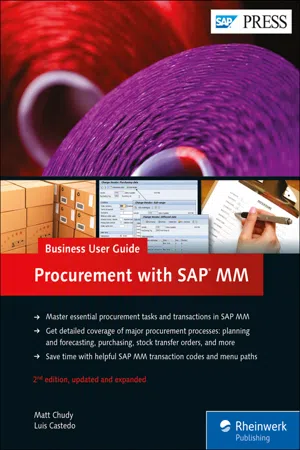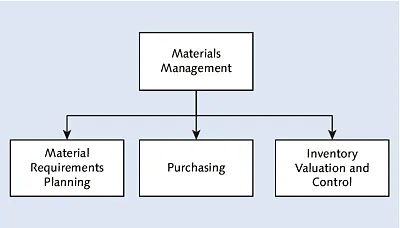
- 533 pages
- English
- ePUB (mobile friendly)
- Available on iOS & Android
Procurement with SAP MM: Business User Guide
About this book
Obtain. Acquire. Procure. Get everything you need with this go-to guide to procurement with SAP Materials Management (SAP MM)! Dive into the key functions and system transactions you'll need for your everyday job, from creating POs or contracts to processing invoices and payments. Discover how to avoid problems and system issues, and explore advanced functions and concepts. Streamline your procurement activities with fewer steps, greater ease, and less effort than ever before! a. Essential Procurement Tasks Master your procurement activities: defining tasks, creating bids, selecting vendors, creating POs or contracts, and processing invoices and payments. Set up your system to receive your goods quickly and economically, and then manage your inventory once you have it.b. Special Procurement ActivitiesWork with outside-the-box tasks, such as providing vendors with materials from your own plant or another vendor, moving stock between warehouses or company codes, and order optimizing. c. EHP 8, SAP HANA, and more!This edition is updated and expanded to incorporate subcontracting and third-party orders, stock transport functionality, and handling unit management. See how new technologies like SAP S/4HANA and SAP Ariba fit into the SAP MM landscape.
Frequently asked questions
- Essential is ideal for learners and professionals who enjoy exploring a wide range of subjects. Access the Essential Library with 800,000+ trusted titles and best-sellers across business, personal growth, and the humanities. Includes unlimited reading time and Standard Read Aloud voice.
- Complete: Perfect for advanced learners and researchers needing full, unrestricted access. Unlock 1.4M+ books across hundreds of subjects, including academic and specialized titles. The Complete Plan also includes advanced features like Premium Read Aloud and Research Assistant.
Please note we cannot support devices running on iOS 13 and Android 7 or earlier. Learn more about using the app.
Information
1 Management at a Glance
1.1 Materials Management Overview
Note
- A robust material requirements planning (MRP) system
- Several different procurement tools that allow you to choose a variety of different ways to interact with vendors
- An inventory control system based on movement types, which allows a different accounting treatment depending on whether the material came in as a result of a purchase order, a production order, or an inventory adjustment or if the materials are taken out of the warehouse for consumption, for production, for order fulfillment, to supply consignment stores, or other movements that may affect the count of materials inside the warehouse and thus the valuation of that inventory in accounting

1.1.1 Material Requirements Planning
1.1.2 Purchasing
Table of contents
- Dear Reader
- Notes on Usage
- Table of Contents
- 1 Management at a Glance
- 2 Master Data
- 3 Planning and Forecasting
- 4 Purchasing from Third Parties
- 5 Intracompany and Cross-Company Procurement
- 6 Kanban
- 7 Order Optimizing
- 8 Procurement of Services
- 9 Inbound Logistics
- 10 Inventory Management
- 11 Logistics Invoice Verification
- A Procurement Tables
- B Working with Procurement Documents: Quick Reference Guide
- C Additional Resources
- D The Authors
- Index
- Service Pages
- Legal Notes